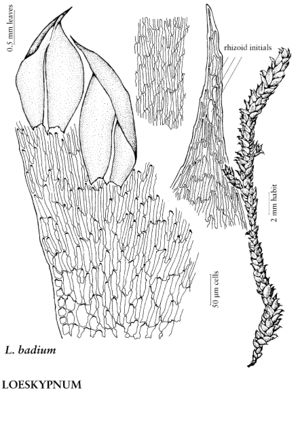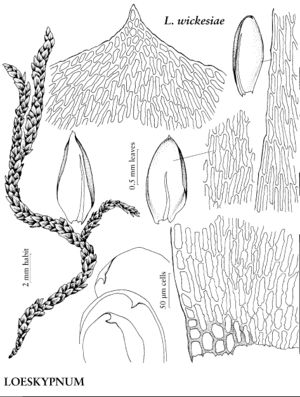Loeskypnum
Bryol. Z. 1: 155. 1918.
| Taxon | Illustrator ⠉ | |
|---|---|---|
 | Loeskypnum badium | Patricia M. Eckel |
 | Loeskypnum wickesiae | Patricia M. Eckel |
Plants medium-sized or rarely large, yellow-green, golden brown, or coppery brown, often blackish proximally. Stems sparsely and irregularly branched; hyalodermis absent, inner cortical cells with walls incrassate, central strand present; outer pseudoparaphyllia broad, triangular; rhizoids or rhizoid initials at various points on leaves, or on scattered points or in rows on stem; axillary hairs well developed, many, distal cells 1–5 (–7), brownish when young or yellowbrown. Stem-leaves ovate or broadly so, oblong, or obovate, gradually or abruptly narrowed to apex, straight or falcate, strongly concave, not plicate; base not decurrent or short-decurrent; margins entire or occasionally sinuate; apex rounded-apiculate or short to long-acuminate; costa single or occasionally 2-fid distally, weak, ending 1/2–9/10 leaf length; alar cells differentiated, rectangular or short-rectangular, slightly inflated, green to hyaline, walls incrassate, region indistinctly delimited, triangular; medial laminal cell-walls incrassate or strongly incrassate, porose. Sexual condition dioicous; inner perichaetial leaves not plicate; vaginula naked or occasionally paraphyses 1 or 2. Capsule horizontal or occasionally inclined; annulus not separating; exostome external surface reticulate basally, margins dentate distally. Spores 13–21 (–23) µm.
Distribution
North America, n Eurasia
Discussion
Species 2 (2 in the flora).
Loeskypnum is usually easily recognized by the sparse branching, rather broad, apiculate or rather short-acuminate and strongly concave stem leaves, and the often golden brown or coppery brown color. The plants are somewhat turgid. Microscopic characters aiding in identification are the strongly incrassate cells throughout the gametophyte, the weak and comparatively short costa, the few and only slightly inflated and differentiated alar cells, and axillary hairs that are brownish or yellow-brown when young. The species of this genus share several rhizoid, perichaetial, and sporophyte character states especially with members of Calliergon, Straminergon, Warnstorfia, and, to some degree, Conardia (Amblystegiaceae). Loeskypnum typically occurs in intermediately mineral-rich and nutrient-poor fens, mostly relatively high in relation to the water table.
Selected References
None.
Lower Taxa
Key
| 1 | Stem leaves falcate, erect-spreading to subimbricate, ovate or broadly ovate, abruptly or gradually narrowed to apex; apices acuminate or short-acuminate, not cucullate. | Loeskypnum badium |
| 1 | Stem leaves straight, ± imbricate, ovate, oblong, or obovate, abruptly narrowed to apex, apices broadly acute, rounded, or apiculate, often cucullate. | Loeskypnum wickesiae |